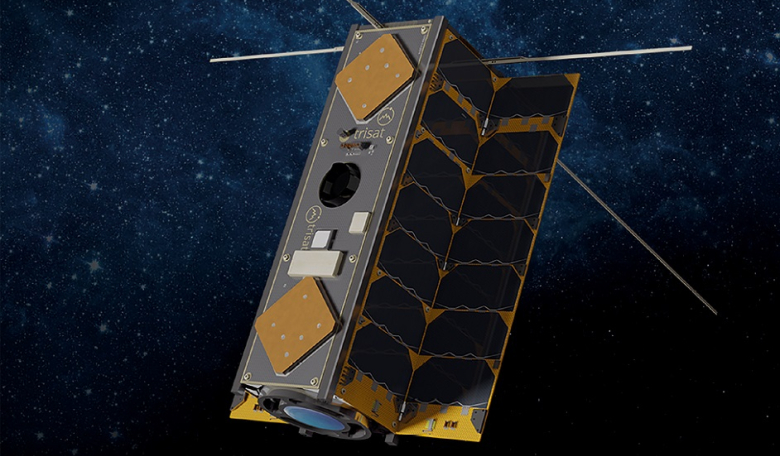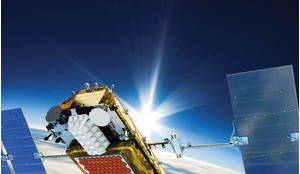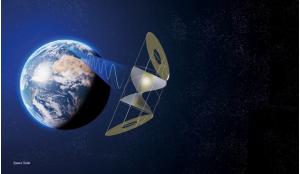In recent years, the small central European country of Slovenia, with a population of only two million and an area of little more than 20,000 square kilometres, has developed a diverse space sector, with the participation of both industry and research institutions. The number and quality of subjects actively engaged in space activities has been constantly increasing over the last decade and this has led to the emergence of diverse areas of expertise and capabilities which exist today in Slovenia. These include engineering and manufacturing of upstream components and platforms, development of ground segment equipment, and exploitation of space data and signals for downstream applications. The Slovenian space industry primarily comprises start-ups and small and medium-sized enterprises (SMEs), initially born in the cradle of the academic sector.
In September 2020, aerospace company SkyLabs became the first Slovenian company with its own technology in Space when, together with the University of Maribor, they successfully launched the first Slovenian satellite. The TRISAT nanosatellite was entirely designed, manufactured, and assembled in Slovenia. The name comes from two words: ‘Triglav’, the highest mountain in Slovenia, and the word ‘satellite’.
With this important turning point, Slovenia became a space nation. This was, and still is, an extraordinary achievement of Slovenian science, technology, and its economy, as the nation dared to go into space, developed new breakthrough technologies for this purpose, pushed the limits of miniaturisation on a global scale and laid the foundations for new opportunities.
Small puzzles with great outcomes
The first engineering model of the TRISAT nanosatellite was presented in 2015 and five years later, in 2020, the first mission was successfully launched
The origins of this great accomplishment date back to 2009, when a European Student Moon Orbiter (ESMO) mission project was held at the Faculty of Electrical Engineering and Computer Science at the University of Maribor (UM). After that initial spark and idea, research and development started in an informal way, and continued until SkyLabs was established in Maribor in 2014. The first engineering model of the TRISAT nanosatellite was initially presented in 2015 and five years later, in 2020, the first mission was successfully launched.
With its key purpose - in orbit technology demonstration - TRISAT is equipped with SkyLabs avionics: a redundant NANOeps electric power system with 30Wh battery pack, full-duplex NANOcomm telemetry (TM) and telecommand (TC) communication subsystem, high performance NANOobc - fault tolerant onboard computer, NANOlink software defined radio-based S-band transceiver with best-in-class SWaP (size, weight and power) characteristics. Its primary payload is a highly miniaturised hyperspectral SWIR (short wave infrared) imager called NANOimager.
Although TRISAT is still transmitting telemetry, it is no longer fully operational. After encountering a debris cloud from a decommissioned Russian satellite about six months after its launch, a failure of some of the solar panels and consequent charging of the battery cells, was detected. This prevents TRISAT from working perfectly so, among other things, it cannot send data captured by the NANOimager. Despite the damage however, it continues to collect measurements of the magnetic field and the satellite’s orbital dynamics, valuable information that has helped to improve its successor.
With the knowledge and experience gained in 2022, SkyLabs, again in cooperation with the University of Maribor, launched a second nanosatellite. Named TRISAT-R, with the suffix R standing for radiation, the mission’s aim is to provide ionising radiation measurements from a medium Earth orbit (MEO) at an altitude of approximately 6000 km. TRISAT-R has already surpassed the forecast that it would ‘survive’ in space for 12 months, since it is still working flawlessly in a highly radiation active orbit, and it is also the first nanosatellite to demonstrate that it is possible to upgrade software at this distance.
SkyLabs again equipped the nanosatellite with NANOsky next generation satellite avionics. Besides the existing avionics that were already tested on TRISAT, TRISAT-R’s overall control, data handling and coordination of subsystems is done by NANOhpm - RISC-V high-performance onboard computer with PicoSkyFT processor. There is also some payload from different partners on board TRISAT-R, such as SpaceRadMon (CERN) and CHIMERA (ESA).
Despite the time spent in MEO and the presence of the Van Allen belts as the major source of intense radiation, the nanosatellite systems still function reliably, demonstrating a successful design, and the quality of the product and components used, which is very important for all the partners of this scientific and educational mission. Additionally, the University of Maribor just signed a collaboration agreement with the European Organisation for Nuclear Research (CERN) that will process the highly valued MEO data obtained by the instrumentation onboard the TRISAT-R satellite.
For communicating with TRISAT-R, SkyLabs established a new ground station on the outskirts of Maribor. The new infrastructure enables narrowband and broadband communication in different frequency bands (VHF, UHF, S, X) for the satellite platforms addressing low and medium Earth orbits.
The third nanosatellite from the TRISAT family, named TRISAT-S, is planned for the first half of 2024. The suffix S stands for security, because the primary goal of the TRISAT-S mission is the technological demonstration of a first secure radio communication with a ground station in the nanosatellite scale space segment.
Inspiring the next generation
Despite the time spent in MEO and the presence of the Van Allen belts as the major source of intense radiation, the nanosatellite systems still function reliably
Dr Iztok Kramberger, from the University of Maribor, believes the two successful missions and the third still in the works, are also very important from an educational perspective since they provide valued experiences for future generations of Slovenian space engineers. “SkyLabs is nowadays employing mainly our graduates. The missions are a starting point for young people who are looking for a career path in this field,” he says. “We are involving students in our team and work, so they can gain first real practical skills on a demanding real-life project. They are growing and evolving with the project and learning in the best possible way - in practice.”
Together with the European Space Agency (ESA) and SkyLabs, UM also established a new study subject, Electronic Systems for Space Applications, which is available for Master’s students. Dr Kramberger says a curriculum that includes space grade courses would speed up the acquisition of knowledge about space technologies, which are drastically needed in the already evolving Slovenian space industry.
Research and development
There is no doubt that space is a very dynamic interdisciplinary field with many opportunities and challenges. It is definitely not a mass industry but it is growing fast. SkyLabs is putting a lot of effort and resource into research. “Looking forward, what will be needed in four to five years, this is one of the most important things in the space industry,” says SkyLabs CEO, Tomaž Rotovnik.
Rotovik recognises that his team is small - around 30 people - but praises their ambition, innovation and professionalism.
“Our backgrounds are very interdisciplinary, from computer, electrical and telecommunication science to physics, mechatronics and mechanical science. A critical mass of knowledge can lead to new innovations, breakthrough technologies and new products. Only in this way can the company be competitive in the international market.” Rotovnik adds that a good team spirit and pursuing the same goal are also very important ingredients for success.
The company has gained international recognition with PicoSkyFT innovation, a small and robust fault-tolerant soft-core processor which today presents a basic building block (supervisor core) in each of SkyLabs’ space grade products - electronic subsystems that form the base avionics stack of every satellite.
A curriculum that includes space grade courses would speed up the acquisition of knowledge about space technologies, which are drastically needed in the already evolving Slovenian space industry
SkyLabs’ first customer was NASA, but nowadays it is also very successfully cooperating with ESA. Since 2020, Slovenia has been an associate member of ESA, but is striving to achieve full membership, which will unlock various benefits. Rotovnik says that with the support of ESA, innovative companies can develop breakthrough technologies which do not yet exist in this field.
A dedicated Slovenian Space Office was also established a few years ago at the Ministry of the Economy, Tourism and Sport, which is important for the space sector in Slovenia. Under their organisation international partnerships and events have been facilitated to help build and maintain an international network of contacts,. Events such as the Slovenian Space Week and ESA days have been set up to provide a further boost to the sector and foster the development of partnerships.
Although Slovenia is a small country, it wants to show Europe and the world what it can do in the field of space technologies and that space is not just a training ground for the biggest players.
Highly miniaturised avionics with fault tolerant features
With its portfolio of products and a range of customers from all over the world, SkyLabs is already proving it is not a ‘one hit wonder’ but a serious star in the space industry - still a small company but with an internationally recognised brand that provides innovative space solutions and with the right mindset to address the challenges of the New Space Age.
SkyLabs’ NANOsky avionics platform comprises highly miniaturised avionics with fault tolerant features. “Single event effect (SEE) immunity, innovative error mitigation techniques, sophisticated three-level fault detection, isolation, and recovery (FDIR) policy, redundancy on all critical functions and thoughtful component selection ensure robustness, high reliability and availability of the platform.” says Dejan Gacnik, CTO of SkyLabs.
The platform is primarily designed for micro-scale satellites, but due to its robustness is successfully also utilised on small-scale satellites. Overall, the platform is present in more than eight different constellation missions with more than 100 units sold.
“Lately, the NANOsky satellite platform has been featured with several new products based on novel technologies, such as the RISC-V processor, secure communication features and many others. The new feature enrichments are not gained by jeopardising any fault tolerance on the equipment itself - that is assured by integrated supervision function in architecture and overall fault tolerant design.” adds Gacnik.
Currently, one of the biggest and most important cooperating relationships for SkyLabs, is the one with OHB-Italia, which is in the process of producing the first batch of 12 satellites for the IRIDE constellation - a unique and innovative constellation designed to observe what is happening on Earth from space.
Although Slovenia is a small country, it wants to show Europe and the world what it can do in the field of space technologies and that space is not just a training ground for the biggest players
SkyLabs will equip the satellites with essential satellite avionics, such as NANOobc, NANOif for Remote Terminal Unit (RTU) functions, their flagship NANOlink-boost S-band communication subsystem with integrated diplexer and the fully fledged all-in-one NANOeps providing a remarkable 172Wh of battery capacity and Power Conditioning and Distribution Unit (PCDU) with more than two dozen protected output channels. Finally, the NANOeps will be charged through NANOamppt units, to provide the most optimal charging conditions.
Over the past few years SkyLabs has also been successfully cooperating with European technology group, DEIMOS. “Cooperation with DEIMOS is an important milestone for SkyLabs, as we have been recognised as a trustworthy supplier in the domain of small-scale satellites.” explains Gacnik.
SkyLabs AOCS (Attitude and Orbit Control System) avionics stack for small satellites is based on a NANOhpm-obc and picoRTU system, which is a combination than can tackle the most demanding AOCS needs.
NANOhpm-obc is a high performance OBC, one of the first solutions with a RISC-V fault tolerant processor inside (NOEL core from FrontGrade Gaisler). The picoRTU system is based on a distributed intelligence thanks to the PicoSkyFT solution, which enables a higher level of subsystem autonomy, higher modularity and interoperability of satellite equipment, thus enabling scalability of actuator and sensor interfaces according to mission needs.
From space to Earth
The cutting-edge innovations developed for space missions can be transferred and applied to various sectors in the Earth segment, leading to significant advancements in technology, science and everyday life. Space technology transfer has the power to address pressing challenges, enhance efficiency, and create new opportunities for sustainable development across multiple industries.
In the case of SkyLabs, one such technology is short-wave infrared (SWIR) spectroscopy, which was applied to automated textile substrate identification and soil quality in smart farming. These new terrestrial technologies were developed based on technology used by the NANOimager, a miniaturised multispectral SWIR imager, which was a main payload on the TRISAT nanosatellite. The transfer of space-based innovations to the earth segment has the potential to revolutionise various industries and address critical challenges faced by humanity.
Exploring new frontiers
Space technology transfer has the power to address pressing challenges, enhance efficiency, and create new opportunities for sustainable development across multiple industries
The quest for knowledge at SkyLabs doesn’t end with satellites alone. To overcome the main disadvantages of classic exploration with wheeled rovers and increase exploration autonomy, the company is developing a light-weight autonomous arachnid all-terrain legged rover called SARA (Slovenian Arachnid Robot Adventurer).
The main disadvantages of vehicle-based exploration are addressed by a nature-inspired arachnid walker using the latest high-performance technology to tackle the issues of complex and fully synchronous kinematic control. Artificial intelligence (AI) plays a major role in enabling the autonomy of exploration by guiding the exploration platform through diverse terrains with many obstacles.
Route planning is often seen as a tedious and challenging task, which can be delegated to Al in combination with various other algorithms for navigation using positioning and environmental sensing.
The legged robot concept is easily adaptable to different scientific applications of exploration and can be considered a potential technological solution for future scientific exploration missions. It also provides the capability of carrying small payloads like scientific instrumentation, and is therefore ideal for autonomous scientific exploration of different surfaces.
In an era where technological advancements are reshaping the boundaries of human capabilities, space technology stands at the forefront and, as we look to the future, the possibilities of space technology seem limitless.
SkyLabs has emerged as a pioneering force, slowly revolutionising the field with its commitment to innovation and a shared vision of pushing the limits - and the company is becoming a well-known name in this ever-evolving industry.
About the author
Pia Prebevšek is a PR & Marketing Manager at Skylabs. She holds a master’s degree in Media Communications from the Faculty of Electrical Engineering and Computer Science at the University of Maribor, Slovenia. Alongside her role at Skylabs, Pia has a versatile skill set as a journalist, events organiser, and events moderator. She loves the challenges her work brings every day and is passionate about working in the Space sector.














